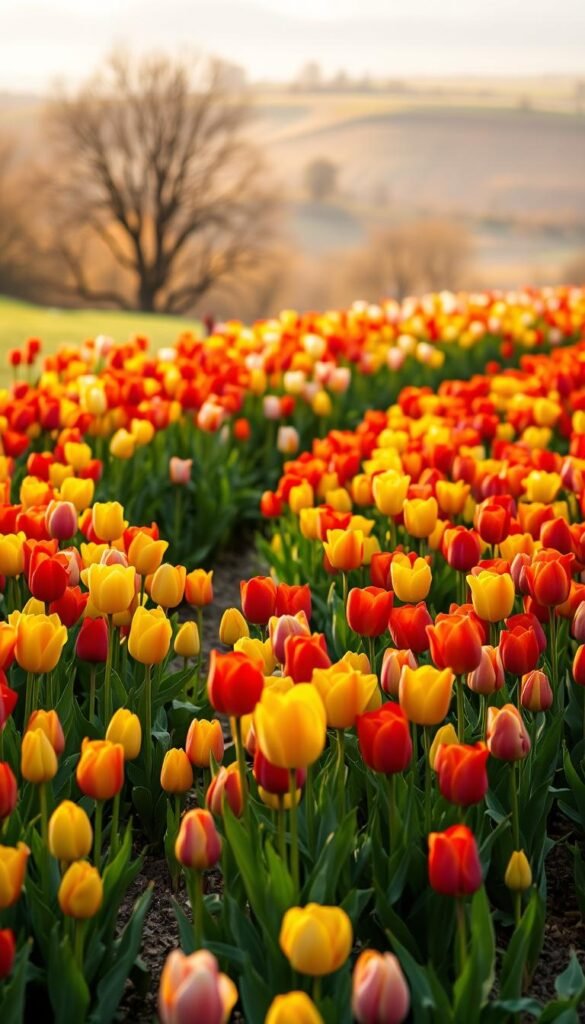Imagine stepping outside to a burst of color that breathes life into your yard. Seasonal flowers offer endless possibilities, but few capture the essence of renewal like these iconic bulbs. Their cup-shaped petals and striking hues have made them a favorite for centuries, blending elegance with cheerful simplicity.
Whether you’re working with a cozy balcony or a sprawling backyard, these plants adapt effortlessly. Their versatility shines in containers, borders, or mixed beds, creating eye-catching displays that evolve through the season. You’ll find varieties suited to every climate zone across the U.S., from early bloomers to late-showstoppers.
Designing with these flowers isn’t just about beauty—it’s about storytelling. Their historical ties to prosperity and passion add depth to your landscape. Strategic placement near walkways or seating areas maximizes their impact, turning ordinary spaces into conversation starters.
This guide unlocks practical tips for crafting cohesive arrangements. Discover how to pair complementary colors, stagger bloom times, and protect your investment from common pests. Let’s create a living masterpiece that reflects your personal style while embracing nature’s rhythm.
Planning Your Dream Tulip Garden
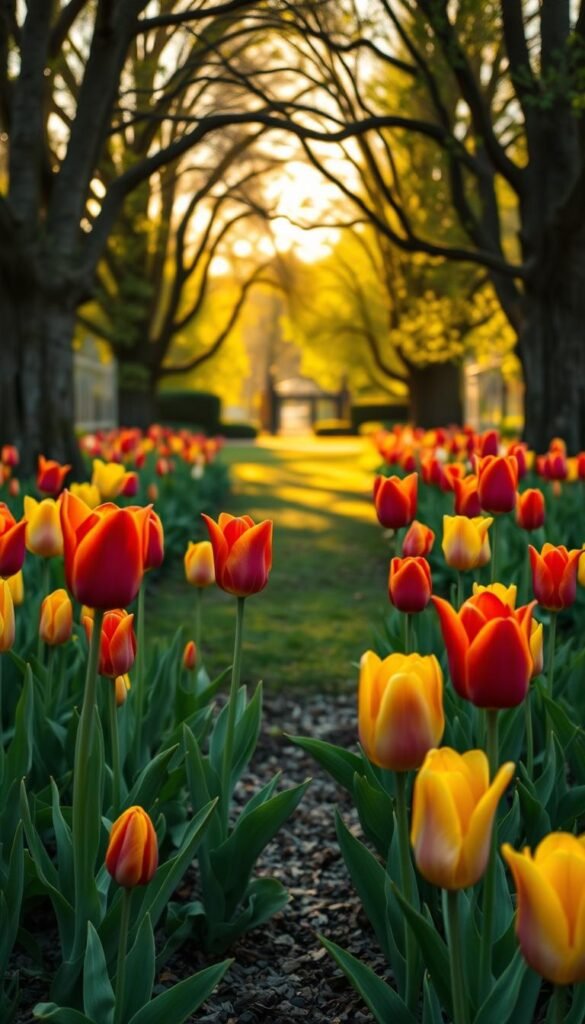
Designing a breathtaking flower bed requires thoughtful groundwork. Start by measuring your outdoor area and noting sunlight patterns. Most varieties need at least six hours of daily sun to thrive. Check your USDA hardiness zone to confirm which types grow best in your region.
Timing proves crucial for success. Plant bulbs in autumn, roughly six weeks before your area’s first freeze. This gives roots time to develop before winter dormancy. Dig holes 6-8 inches deep—shallower depths might leave bulbs vulnerable to frost damage.
Test your soil’s drainage by digging a 12-inch hole and filling it with water. If it takes over an hour to drain, mix in sand or compost. Well-aerated earth prevents rot and encourages healthy growth. For landscaping projects, consider how taller varieties can create natural backdrops while shorter ones frame pathways.
Create a bloom calendar using local frost dates. Early-season types like ‘Red Emperor’ kick off the show, while parrot tulips extend color into late spring. Space bulbs 4-6 inches apart, adjusting for each cultivar’s mature size. This strategic approach ensures waves of color that evolve throughout the season.
Tulips Garden Aesthetic: Bold Spring Blooms to Brighten Your Landscape
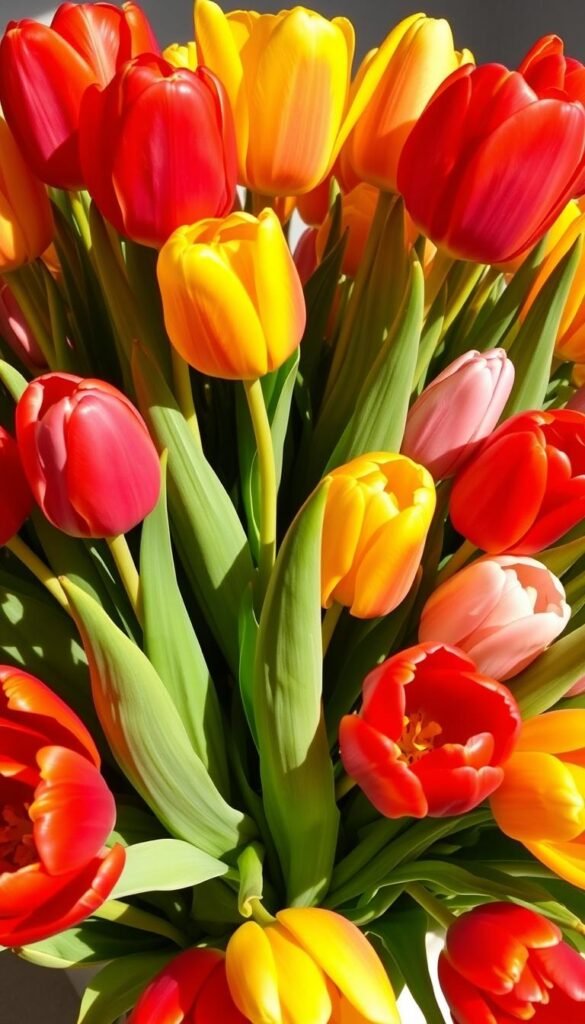
Crafting a visually stunning floral display begins with understanding color relationships. Warm reds and oranges energize spaces, while cool purples and whites add calm sophistication. Pairing contrasting hues like deep maroon with lemon yellow creates dynamic focal points that command attention.
Did you know studies show vibrant petals boost mood by up to 30%? Their cup-shaped forms and vibrant tones trigger feelings of joy and optimism. This makes them perfect for creating inviting outdoor areas that feel like natural retreats.
- Monochromatic schemes using varying shades of pink
- Complementary duos like purple and yellow
- Triadic arrangements with red, blue, and yellow varieties
Balance dramatic clusters with softer accents near patios or entryways. Taller parrot varieties work well behind benches, while shorter doubles soften hardscapes. Remember – your design should feel intentional yet effortless, blending structured beauty with nature’s spontaneity.
When planning layouts, leave breathing room between color blocks. This prevents visual overload and lets each bloom shine. The result? A living canvas that evolves daily, celebrating renewal through carefully curated floral artistry.
Essential Steps for Planting and Caring for Tulips
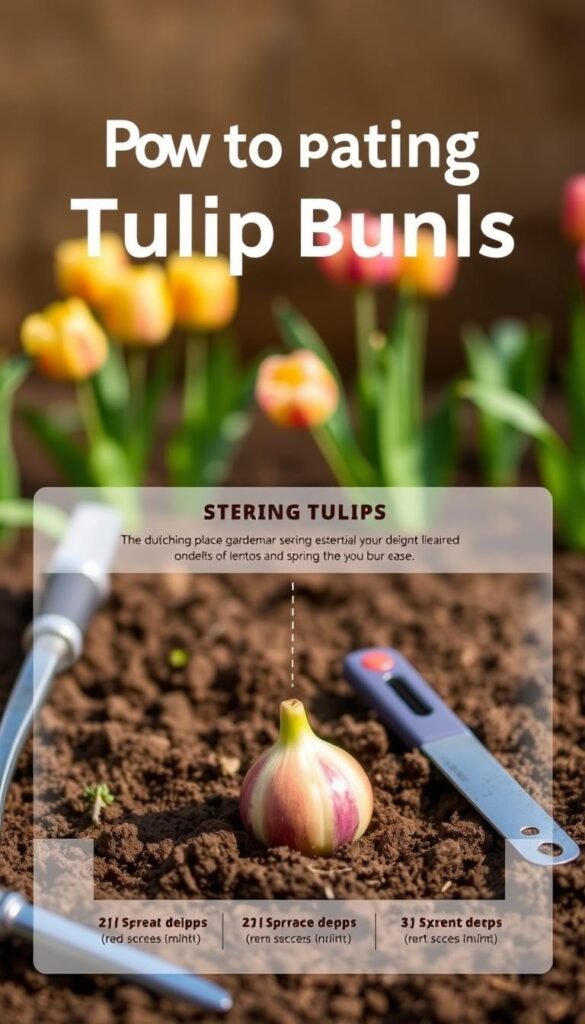
Nurturing vibrant floral displays starts with mastering bulb fundamentals. Begin by choosing a sunny spot with soil that drains quickly—soggy roots spell trouble. If puddles linger after rain, mix in compost or sand to improve drainage before planting.
Plant bulbs pointy-end up in autumn, digging holes 6-8 inches deep. Space them 4-6 inches apart so each has room to grow. Cover with soil and press firmly to eliminate air pockets that could dry out roots.
Water deeply after planting, then only when the top inch of soil feels dry. Overwatering causes bulbs to rot, while underwatering leads to stunted growth. Watch for yellowing leaves—they signal you’re giving too much H2O.
Ongoing care keeps your display thriving. Remove spent blooms but leave foliage until it yellows naturally. This lets plants store energy for next year’s show. For cut flowers, snip stems at an angle and change water daily to extend their cheer.
Pro tip: Sprinkle crushed eggshells around bulbs to deter slugs. Rotate planting locations every 2-3 years to prevent disease buildup. With these simple steps, you’ll create a flourishing display that returns stronger each season.
Creating a Color Pop Pathway with Bold Tulip Varieties
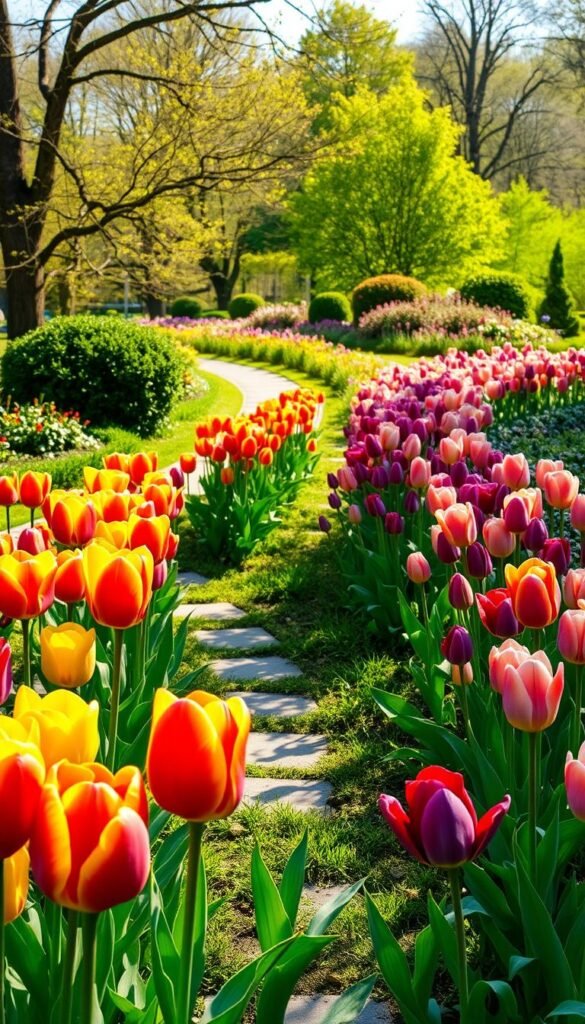
Want to turn ordinary walkways into dazzling floral arteries? Strategic bulb placement transforms functional paths into living ribbons of color. The secret lies in choosing varieties that combine durability with showstopping hues, creating routes that guide visitors while delivering wow-factor moments.
Optimal Bulb Placement
Frame stone or gravel paths with Tulip ‘Orca’ for crisp definition. Space bulbs 6 inches apart along edges, creating parallel lines that draw the eye forward. This variety’s ivory-and-maroon petals contrast beautifully against earthy textures, making pathways appear wider and more inviting.
Clustering for Maximum Impact
Group 5-7 ‘Candy Prince’ bulbs every 3 feet for punchy lavender bursts. Their sturdy stems handle accidental kicks better than delicate varieties. In high-traffic zones, plant 4 bulbs per square foot—dense enough for visual drama but spaced to prevent overcrowding.
Mix these techniques for dynamic results:
- Alternate color blocks between pathway sections
- Use taller varieties near seating areas
- Edge narrow paths with single bulb rows
Pro tip: Pair cool-toned flowers with warm-hued mulch to intensify color contrasts. Your pathways will become more than routes—they’ll be destination features that celebrate smart design.
Feng Shui Flower Beds to Enhance Positive Energy
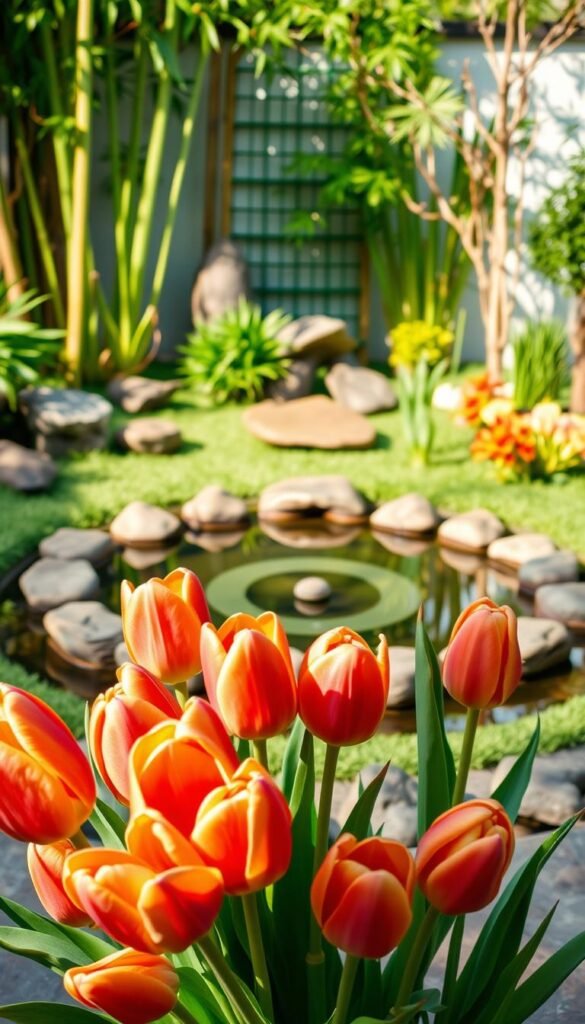
Your outdoor space becomes more than a visual treat when aligned with natural energy principles. Strategic placement of floral elements can transform stagnant areas into vibrant zones that uplift both mood and atmosphere. Studies show well-designed green spaces reduce stress by 28%, making this approach both practical and spiritually rewarding.
Harnessing Odd-Numbered Groupings
Feng shui wisdom favors clusters of 3, 5, or 7 bulbs for their dynamic balance. Odd numbers create movement, guiding energy flow through curved patterns rather than rigid lines. Try circling a birdbath with seven ‘Candy Prince’ stems or framing steps with trios of ‘Orca’ blooms.
Entry points deserve special attention. Position five ivory-and-maroon bulbs near your front door as a living invitation to positive vibes. For back patios, arrange nine deep purple varieties in crescent shapes to soften sharp corners. These groupings act as natural conductors, harmonizing your surroundings.
Color symbolism amplifies effects:
- White varieties promote clarity
- Red tones ignite passion
- Yellow petals attract joy
Remember, your design should feel effortless. Allow winding paths between clusters to let chi circulate freely. With thoughtful placement, you’ll craft spaces that nourish both eyes and spirit.
Container Design Delight for Urban Spaces
City living doesn’t mean sacrificing floral drama—containers bring vibrant life to concrete jungles. These portable gardens let you transform fire escapes, rooftops, and tiny patios into seasonal showcases. With smart design choices, even postage-stamp spaces burst with botanical charm.
Selecting the Perfect Container
Size matters most when choosing pots. Opt for 12-inch diameter containers minimum—smaller homes restrict root growth. Terra cotta breathes well but dries quickly, while glazed ceramic retains moisture longer. Ensure drainage holes exist; drill extras if needed.
Material impacts style:
- Sleek metallic planters for modern high-rises
- Distressed wooden boxes in cottage-style settings
- Self-watering plastic systems for busy renters
Layering with Complementary Plants
Pair Tulip ‘Orca’ with trailing ivy or creeping thyme for vertical interest. These companions hide fading foliage while adding texture. In deeper containers, plant grape hyacinths below tulip bulbs—they’ll bloom sequentially for extended color.
Try these dynamic duos:
- Purple pansies beneath ivory blooms
- Silver dust miller framing crimson petals
- Dwarf conifers anchoring pastel varieties
Space 5-7 bulbs per 14-inch pot, leaving 2 inches between each. Top-dress with moss or pebbles to retain moisture and elevate your design. Suddenly, that balcony becomes an envy-inducing oasis.
Layered Blooming Borders for Depth and Interest
Transform flat flower beds into dimensional masterpieces through strategic layering. This approach creates borders that intrigue viewers from every angle while extending visual appeal across seasons. Let’s explore how to build dynamic displays where every plant plays a purposeful role.
Designing with Varying Heights
Start by positioning Tulip ‘Orca’ at the border’s edge. Their crisp ivory-and-maroon petals pop against greenery, making them ideal front-row performers. Behind them, plant foxgloves or salvias that reach 24-36 inches—these vertical elements add architectural interest without overshadowing your stars.
| Plant Type | Height Range | Bloom Period |
|---|---|---|
| Tulip ‘Orca’ | 10-14″ | Early Spring |
| Foxgloves | 24-36″ | Late Spring |
| Salvia | 18-30″ | Summer |
Seasonal Color Coordination
Extend your border’s performance with plants that bloom sequentially. After ‘Orca’ fades, peonies take center stage in late spring. Come summer, coneflowers and black-eyed Susans maintain the show. This rotation ensures nonstop vibrancy while letting each plant shine during its prime.
Consider these pairings for depth:
- Low-growing sedum fronts mid-height alliums
- Feathery grasses behind dwarf irises
- Climbing roses framing late-season dahlias
Remember to leave negative space between groupings. This breathing room prevents visual clutter and highlights your careful curation. With thoughtful layering, your borders become living sculptures that evolve beautifully through the seasons.
Seasonal Showstopper Displays for Continuous Blooms
Turn your outdoor space into a living calendar of color that evolves week by week. Strategic planning lets you craft floral displays that transition seamlessly from early warmth to late-season brilliance. Focus on high-visibility zones like entryways and patio edges where color makes the strongest impression.
Timing Your Planting for a Spring Spectacle
Map out bloom periods using this simple formula: early + mid + late varieties = nonstop vibrancy. Start with species like ‘Praestans Fusilier’ (weeks 1-3), then transition to Darwin hybrids (weeks 4-6), finishing with frilled double-late types (weeks 7-9). This staggered approach keeps beds lively for 12+ weeks.
| Variety Type | Bloom Period | Companion Plants |
|---|---|---|
| Early Season | March-Early April | Pansies, Grape Hyacinth |
| Mid Season | Mid April-May | Daffodils, Forget-Me-Nots |
| Late Season | May-June | Alliums, Peonies |
Pair bulbs with perennials that fill gaps as petals fade. For creative gardening ideas, try underplanting with creeping phlox—its evergreen foliage hides dying stems while adding texture. Rotate bulb locations annually to refresh soil nutrients and prevent disease buildup.
Pro tip: Mark planting areas with labeled stakes each fall. This prevents accidental digging and helps track which varieties thrive in specific microclimates. With smart timing, your space becomes a rotating gallery of floral artistry that neighbors admire year after year.
Integrating Mixed Tulip Varieties for Vibrant Gardens
Unlocking your outdoor space’s full potential starts with mastering the art of floral partnerships. By weaving together diverse bulb varieties, you craft living tapestries that captivate from first bud to final bloom. This approach transforms static beds into evolving showcases where each plant enhances its neighbors.
Blending Colors and Shapes
Pair Darwin Hybrids with frilly Parrot types for textural contrast. Their sturdy stems and wild petals create visual excitement without clashing. Alternate warm and cool tones in repeating patterns—scarlet blooms beside violet alliums, or creamy whites fronting deep purples.
Use height variations to guide the eye upward. Place low-growing species like Tulipa humilis along edges, with taller Rembrandt varieties behind them. This layering trick adds depth while letting sunlight reach every stem. For balance, match bold focal flowers with delicate fillers like forget-me-nots.
Remember these principles for harmony:
- Repeat key hues across different sections
- Limit palette to 3-4 dominant colors
- Mix rounded and pointed petal shapes
Your creation becomes a seasonal symphony where each variety plays its part. With smart pairings, you’ll achieve professional polish while expressing your unique vision through nature’s vibrant palette.

